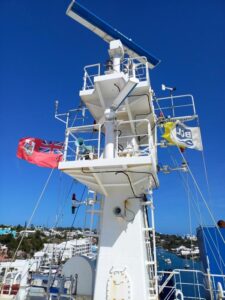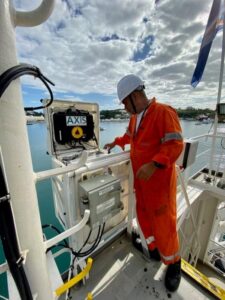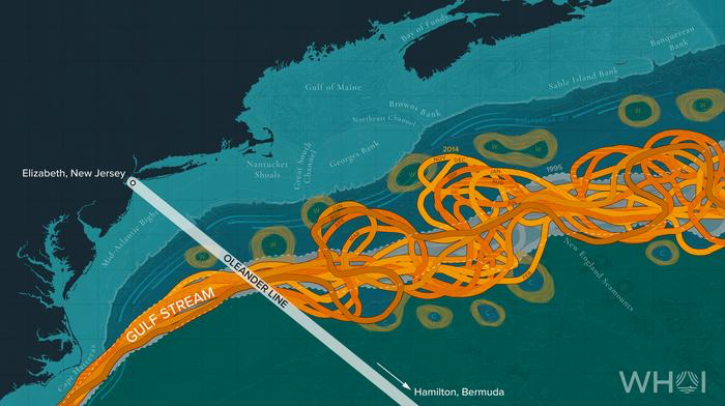A team of researchers has published a study in Frontiers in Ocean Observing detailing how the merchant marine vessel CMV Oleander is contributing to ocean observations and data collection and providing peer-reviewed data on the Middle Atlantic Bight shelf, Slope Sea, Gulf Stream and Sargasso Seas.
Measuring the ocean
CMV Oleander, operated by Bermuda Container Line/Neptune Group, is part of an initiative between the merchant marine container vessel and a team of researchers from multiple institutions including the Woods Hole Oceanographic Institution (WHOI) and the Arizona State University / Bermuda Institute of Ocean Sciences (ASU BIOS).

Since the 1970s, scientific equipment has been mounted on three different container ships operating consecutively on the “Oleander Line”, resulting in decades of scientific data. The newest MV Oleander came into service in 2019, and is now providing regular water column, sea surface and atmospheric measurements.
In the article extract, the researchers highlight how the merchant marine container provides scientists with a window into upper ocean currents, water properties and marine ecology twice per week while in service between New Jersey and Bermuda. Its temperature, salinity and carbon dioxide concentrations measurements complement satellite measurements and contribute to global observing programs – including the Global eXpendable BathyThermograph (XBT) Network, the Surface Ocean CO2 Atlas (SOCAT) and the Continuous Plankton Recorder (CPR) Survey.
“Sustained observations of temperature, salinity and carbon dioxide concentrations along the Oleander Line have provided critical information about our changing oceans, including the warming and shrinking of the Slope Sea and a northward shift of the Gulf Stream,” said Magdalena Andres, a senior scientist in WHOI’s Department of Physical Oceanography, and lead author on the study.
The Oleander Program
The Oleander Program is funded by the US National Science Foundation Division of Ocean Sciences with the XBT probes supplied by NOAA/AOML and is made possible by the Bermuda Container Line/Neptune Group and the expertise and support of the ship’s captains, chief engineers and crew.

The Oleander Project is a part of the Science RoCs (Research on Commercial Ships) initiative, which aims to equip many more commercial vessels with sensors to measure physical, chemical and biological characteristics of the ocean along the world’s major shipping routes. The current custodians of the National Science Foundation-funded (NSF) Oleander Project are led by WHOI and comprise ASU BIOS, Stony Brook University, and University of Hawaii with key contributions also by the University of Rhode Island, one of the founding institutions of the partnership.
“The long-standing cooperation between scientists and the Bermuda Container Line/Neptune Group serves as a model,” said Tim Noyes, marine ecologist and research fellow at ASU BIOS and co-author of the study. “In situ measurements provided by ships can complement satellites and be an important part of global observing systems. Along with a suite of other observatory tools, this region of the world’s ocean is revealing some of the changes underway and helping us to predict and respond to future changes.”
“The industry has signaled that it is willing to help as scientists seek to expand their ability to collect sustained observations of the atmosphere and upper ocean waters to advance science and address pressing global challenges,” said Kerry Strom, senior manager in WHOI marine operations and co-author on a recent study documenting best practices for recruiting vessels of opportunity for seagoing data collection.
“With its integrated system of scientific sensors, MV Oleander serves as an interdisciplinary observatory in the Northwest Atlantic that can be replicated elsewhere to aid scientists who have only limited access to the seas. The successes of Oleander’s operation over the last 50 years demonstrate that partnering with the merchant marine can increase this access.”
In related news, scientists at University College London (UCL), the National Oceanography Centre (NOC) and the École Normale Supérieure (ENS) Paris-Saclay in France recently announced they will capture novel observations of coastal wave breaking and use advanced modeling and machine learning (ML) to work out the impacts of coastal wave breaking on the climate system to plug a gap in current climate models. Click here to read the full story.



